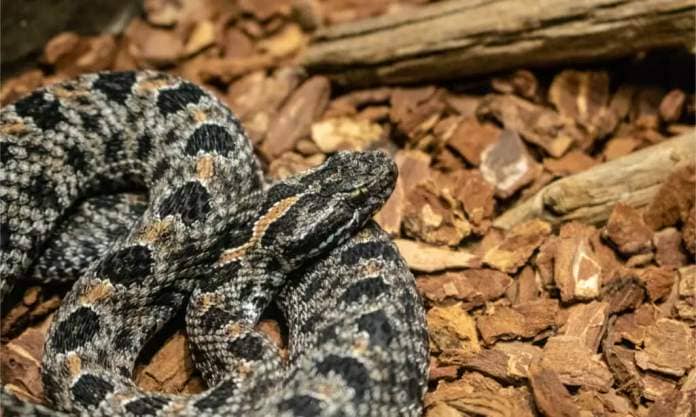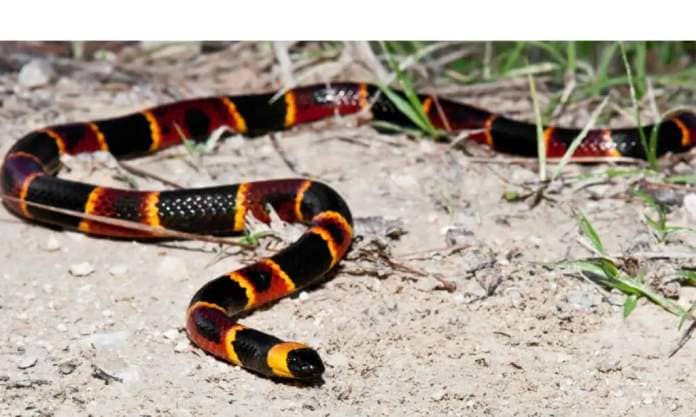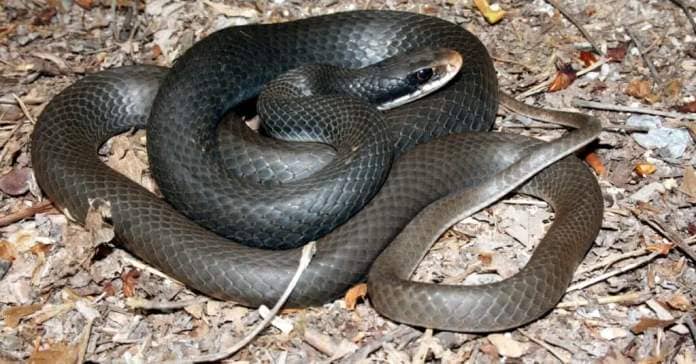↓ Continue Reading To See This Amazing Video
Florida’s climate is excellent for reptiles of all kinds. Officially, Florida has 46 native snake species with six venomous danger noodles. However, at least four non-native snakes have taken advantage of the Sunshine State’s nearly perfect reptile weather.
Depending on where your Florida garden is located, you may have more or fewer of these species. We consulted iNaturalist.org for the numbers because, while the numbers may be imperfect, they’re not bad. The only caveat is that they are all user-submitted, so the number of users in a given area partly determines the number of sightings.
In the interest of safety, we begin with how to tell if a snake is venomous. I’m a firm believer in being 150% confident in your ability to identify the really dangerous plants and animals before messing with them.
Knowledge is power, after all!
How to Identify Venomous Florida Snakes
Most venomous snakes in the United States are pit vipers in the Crotalinae subfamily. They are thick-bodied with strongly keeled scales. These snakes have vertical pupils and large heads set on small necks. In addition, all of our U.S. pit vipers give live birth. We call them pit vipers because there’s a heat-sensing loreal pit between their nostril and eye on each side. While their eyes are important, most snakes don’t have the greatest vision. It’s their pits that make these nocturnal hunters so effective – their pits let them “see” heat in the dark.
This group of snakes is highly venomous and behind their eyes are big venom glands that attach to their hollow, hinged fangs. Most have hemotoxic venom, but a few species have neurotoxic or cytotoxic venom. They hunt various small animals, from cicadas and other insects to frogs, fish, rodents, and birds.
Of Florida’s venomous snakes, the eastern coral snake is the only one that isn’t a pit viper, and we’ll get into identifying it in a minute.
Although these snakes may be frightening, they don’t want to bite you. Up to 50% of all bites can be dry — having no venom. A snake’s venom costs time and energy to produce, so using it just to scare off an attacker isn’t always helpful, so they don’t always envenomate.
Florida’s Most Common Venomous Snake: The Florida Cottonmouth (Agkistrodon conanti)
Yep, Florida has its very own cottonmouth variety. People fear cottonmouths in general, but they’re more afraid of you than you realize. Cottonmouths get a bad rap because they’re more likely to stand their ground than other snakes. These slow-moving snakes can’t beat a hasty retreat anywhere, so they stay put, hoping you’ll leave.
As slow as they generally move, they have one of the quickest strikes of all the snakes and beat out the Gaboon viper by a fraction of a meter per second.
The Florida cottonmouth inhabits most of Florida, and is the state’s most common venomous snake. However, they tend to shy away from residential areas unless it’s in one of Florida’s many river- or lake-front communities.
These snakes have dark crossbands with lighter centers over a tan, olive, or even black base. The edges of their bands are often somewhat jagged, giving them a pixelated appearance – as if you zoomed into a photo too far. On the sides of their heads, Florida cottonmouths have dark stripes with light edging and two darker vertical lines on the chin.
Florida cottonmouths change color as they age, too. When they’re young, they look a lot like copperheads, complete with the brightly-colored tail tip. However, copperheads rarely have a head stripe and only occur in a small Florida panhandle area.
In addition to this is the snake’s common name: cottonmouth. We call them cottonmouths because they throw their mouths open and show off a cotton-white mouth. It’s their threat display, and no other pit viper in the U.S. does this.
Florida cottonmouths average between 24 and 48 inches long, but the occasional six-footer isn’t uncommon. Like the rest of the pit vipers in their family, they are thick-bodied snakes. In addition, when swimming, these snakes tend to hold their heads above the water, but if they’re coming up from fishing, you may not be able to see that.

©Kristian Bell/Shutterstock.com
Dusky Pygmy Rattlesnake (Sistrurus miliarius barbouri)
The second most common venomous snake in Florida is one of the smallest rattlesnake species. But this 12 to 24-inch-long rattlesnake is mighty! Like most pit vipers, this species is thick-bodied for its size and has a large head with a thin neck. It also has thermo-vision as a superpower, with its heat-sensitive pits – a handy thing because its eyesight isn’t all that terrific. Although a bite from a dusky pygmy rattlesnake isn’t usually life-threatening for people, it can pose a risk of serious injury to children and pets.
Dusky pygmy rattlesnakes have a gray background with a reddish-orange dorsal stripe interrupted by distinctive reddish-brown saddle markings. In addition, this species has a black diagonal stripe that begins behind each eye and sometimes has white borders above and below. They have elliptical pupils and nine large scales on the top of their heads. As juveniles, they have bright yellow tails, but even adults have tiny rattles that produce a high-pitched buzz instead of their larger cousins’ classic “rattle” sound.
While these rattlesnakes aren’t as commonly encountered in some regions, Florida seems to have a pretty healthy population of this subspecies. Residents in suburban neighborhoods find this snake fairly regularly, especially where the neighborhood borders their habitat. It typically prefers lowland pine flatwoods, prairies, areas around lakes and ponds, and the edges of marshes or cypress swamps.

©Suzanna Ruby/Shutterstock.com
Eastern Diamondback Rattlesnake (Crotalus adamanteus)
The big, bad, feared…coward.
Although you may be (rightfully) nervous about venomous snakes, especially rattlesnakes, remember that rattlesnakes are cowards first. Benjamin Franklin said they were great symbols of the colonies because they were always vigilant and never started a fight, but “once engaged, never surrendered.” But, of course, he also wanted the national bird to be a turkey.
Don’t misunderstand; I love rattlesnakes and they utterly fascinate me – even though they also scare me a bit. However, the key to coexisting with these danger noodles is understanding that they’re genuinely more afraid of you. Give the big bad chicken snake some escape room, and more often than not, escape is what it will choose.
The eastern diamondback rattlesnake is the third most common venomous snake in Florida. It’s also the largest rattlesnake species, sometimes weighing in at 34 pounds and nearly eight feet long. It has a huge triangular head, vertical pupils, a skinny neck, and a thick body. Eastern diamondback rattlesnakes have a dark, almost black, stripe that begins behind their eye and extends diagonally downward toward the lip. This postocular stripe usually has a lighter yellow to creamy-white border. The snake has an olive, brown, brownish-gray, or brownish-yellow background color and black or brown diamonds along its spine.
This species can grow some pretty impressive rattles, but like other rattlesnakes, they break off pretty often. Eastern diamondback rattlesnake bites can be fatal to humans simply because of the volume of venom they can inject with a single bite.
This symbol of America prefers scrublands, coastal forests, and pine flatwoods. They occur throughout Florida; eastern diamondback rattlesnakes are the third-most common venomous snake in Florida. Of course, you’re not as likely to encounter these snakes in your garden as the pygmy rattlesnake or cottonmouth, but it wouldn’t be impossible.
Eastern Coral Snake (Micrurus fulvius)
You’re not likely to find this species in your garden because it is really shy and fossorial. The eastern coral snake spends most of its time under rocks and debris in rodent tunnels. I only bring it up because it’s also highly likely to be picked up by kids – it’s a pencil-thin beauty that’s usually less than 24 inches long with red, yellow, and black bands that extend around its body.
The easiest way to identify it is to look for the wide yellow band right behind its eyes and the black snout. Yes, I know, there’s a rhyme. But get it wrong, use it in South America, or find a snake with a mutation in its pattern, and you may have a nasty bite that needs medical attention.

©iStock.com/JasonOndreicka
Other Venomous Snakes in Florida
Florida has a few other venomous snakes. Fortunately, they aren’t encountered as often as all of the nonvenomous species.
One last note: In the U.S., if you see a snake with vertical labial bars, it is nonvenomous because none of our venomous snakes have that feature. However, not seeing vertical labial bars doesn’t automatically mean it’s venomous.
Now we can move on to the nonvenomous garden helpers you may find!
The Most Common Nonvenomous Snake in Florida: the Southern Black Racer (Coluber constrictor priapus)
These quick-moving snakes are notorious bluffers and will repeatedly bite when cornered. But they’re harmless unless you’re a small mammal, frog, toad, turtle, lizard, snake, egg, or young bird. So, they can squeeze anything down their throat because, as juveniles, they’ll even eat insects. Fortunately, even though these snakes are opportunistic feeders, anything bigger than a rabbit is probably safe.
According to iNaturalist.org, they’re sighted over most of the U.S., with the highest concentration of sightings in Florida. There are numerous subspecies that we collectively call eastern racers or North American racers. If you’re trying to figure out which subspecies you found in your tree in Florida, it’s most likely the Southern black racer.
Racers, or runners as some people call them, move fast. In fact, they’re more likely to spot you first and take off before you see them. That said, their measured speed is only about four miles per hour. It just looks fast because it’s a thin legless thing doing the moving!
Juveniles are gray with reddish-brown saddle markings down their backs that fade into a solid color near the tail. It wasn’t for the large, friendly eyes and pointy snout; you could mistake it for a young ratsnake. By their second year, the juvenile pattern is completely gone.
Adult southern black racers are solid grayish-black with white chins and throats. Their belly has no markings and is also grayish to black, although it’s usually a little lighter than the back. These snakes are excellent climbers and often cruise through the trees while they hunt. Most racers measure 20 to 56 inches long. However, the record length was 72 inches!

©Psychotic Nature/Shutterstock.com
Banded Watersnake (Nerodia fasciata)
In a state known for its swamps, lakes, and rivers, I’m not surprised a watersnake is near the top of our list!
People often mistake the nonvenomous banded watersnake for the venomous cottonmouth. However, once you understand the basics, it’s easy to identify them correctly.
Banded watersnakes are large-bodied with broad heads. They have round pupils and vertical lines running from the lower lip to the upper lip (called labial bars). Their heads are somewhat distinct from the neck.
As juveniles, banded watersnakes are gray, greenish-gray, or brown with dark crossbands. As they age, they become darker and darker, leading people to mistake them for cottonmouths. Adults measure between 24 and 42 inches long, but the Florida record was 62.5 inches.
These snakes have yellowish-to-white bellies and strongly-keeled scales. These snakes are widespread in Florida. They’re most often found in and around the water, hunting for fish and frogs.
Corn Snake (Pantherophis guttatus)
Also called the red rat snake, corn snakes are common in the eastern United States. Like their cousin, the eastern rat snake, corn snakes are great at getting into trouble. They live side-by-side with humans with relative ease and don’t mind exploring new places. If that new place is your house, then all the better!
All joking aside, if you find a rat snake in your house, you should probably check for rodents. They follow their nose, and if it leads them to your home, they may be saying something.
Corn snakes have black-outlined, reddish-orange blotches down the length of their back. The blotches are roughly rectangular, and there’s typically a strong contrast between these and their lighter base color, varying from creamy tan to brick-red. These snakes are nonvenomous colubrids that have round pupils and slender bodies. People sometimes confuse them for copperheads, but a copperhead has a much thicker body. Their bellies almost always have a checkered pattern, which is one of the species’ identifying factors.
Like all of the snakes in the Pantherophis genus, corn snakes are superb climbers. You’ll find them in odd places — on the side of the brick wall, hanging down from the garage rafters, you name it.

©iStock.com/praisaeng
Other Nonvenomous Florida Snakes
Here are a few more of the dozens of snake species that call Florida home:
Introduced and Invasive Snakes in Florida
Invasive Burmese pythons have established a breeding population in Florida and made the news. These non-native snakes are wreaking havoc on the ecosystem. However, there are more introduced species.
Not all of these have confirmed breeding populations — the brahminy blind snake does, but it’s not clear how much damage it’s causing if any. Some are probably escaped pets — snakes are notorious escape artists.
Next up
Discover the “Monster” Snake 5X Bigger than an Anaconda
Every day A-Z Animals sends out some of the most incredible facts in the world from our free newsletter. Want to discover the 10 most beautiful snakes in the world, a “snake island” where you’re never more than 3 feet from danger, or a “monster” snake 5X larger than an anaconda? Then sign up right now and you’ll start receiving our daily newsletter absolutely free.


